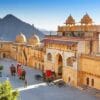Summary
The Jama Masjid in Agra, built in 1648 AD by Shah Jahan for his daughter Jahanara Begum, is a magnificent Mughal-era mosque. Featuring Persian and Indian architecture, it has a vast courtyard, intricate carvings, and striking domes. It remains a significant religious and historical landmark in Agra.
Location
- Jama Masjid, Subash Bazar, Kinari Bazar, Hing ki Mandi, Mantola, Agra, Uttar Pradesh 282003
⬇️Tap on “View larger map” to get Direction
Full Story
The Jama Masjid in Agra, also known as the “Friday Mosque,” is one of the most significant and majestic mosques in India. Built during the Mughal era, this architectural marvel stands as a testament to the grandeur and religious devotion of the Mughal emperors. Let’s delve into the rich history, architectural brilliance, and cultural significance of the Jama Masjid in Agra.
1. Historical Background
- Construction: The Jama Masjid was built in 1648 by Shah Jahan, the fifth Mughal emperor, who is also renowned for constructing the Taj Mahal.
- Dedication: The mosque was dedicated to Jahanara Begum, Shah Jahan’s favorite daughter, who played a significant role in the Mughal court.
- Purpose: It served as a place of worship for the Mughal emperors and the general public, reflecting the emperor’s commitment to Islam and his subjects.
2. Architectural Brilliance
The Jama Masjid is a stunning example of Mughal architecture, blending Persian and Indian styles. Key architectural features include:
A. Grand Entrance
- Buland Darwaza: The mosque is accessed through a massive gateway known as the Buland Darwaza (Gate of Magnificence), which is adorned with intricate carvings and calligraphy.
B. Main Prayer Hall
- Central Dome: The mosque features a large central dome, flanked by two smaller domes, creating a harmonious and balanced design.
- Pillared Hall: The main prayer hall is supported by numerous pillars, each intricately carved with floral and geometric patterns.
C. Courtyard
- Spacious Courtyard: The mosque has a large open courtyard capable of accommodating thousands of worshippers during Friday prayers and religious festivals.
- Water Tank: A traditional wazu khana (ablution tank) is located in the courtyard, used by worshippers for ritual cleansing before prayers.
D. Minarets
- Tall Minarets: The mosque is flanked by four tall minarets, which not only add to its grandeur but also serve as a visual representation of Islamic architecture.
E. Decorative Elements
- Calligraphy: The walls and ceilings of the mosque are adorned with exquisite calligraphy, featuring verses from the Quran and Islamic inscriptions.
- Marble and Red Sandstone: The use of red sandstone and white marble in the construction adds to the mosque’s aesthetic appeal and durability.
3. Historical Significance
- Religious Hub: The Jama Masjid has been a central place of worship for Muslims in Agra for centuries, playing a vital role in the religious and social life of the community.
- Mughal Legacy: The mosque is a symbol of the Mughal Empire’s architectural and cultural achievements, reflecting the emperors’ devotion to Islam and their patronage of the arts.
- Cultural Heritage: As one of the largest mosques in India, the Jama Masjid is an important part of Agra’s cultural and historical heritage.
4. Cultural and Religious Importance
- Friday Prayers: The mosque continues to host Friday prayers, attracting thousands of worshippers from across the city.
- Religious Festivals: It is a focal point for major Islamic festivals, including Eid al-Fitr and Eid al-Adha, where the community gathers for prayers and celebrations.
- Tourist Attraction: The Jama Masjid is a popular destination for tourists, offering a glimpse into the rich history and architectural brilliance of the Mughal era.
5. Preservation and Restoration
- Maintenance: The mosque has been well-preserved over the centuries, thanks to the efforts of the local community and the Archaeological Survey of India (ASI).
- Restoration Projects: Periodic restoration work has been undertaken to maintain the mosque’s structural integrity and aesthetic beauty.
6. Why Visit Jama Masjid, Agra?
- Architectural Marvel: The mosque’s stunning design and intricate details make it a must-visit for architecture enthusiasts.
- Historical Insight: A visit to the Jama Masjid offers a deeper understanding of the Mughal era and its cultural and religious significance.
- Spiritual Experience: The serene and spiritual ambiance of the mosque provides a peaceful retreat for visitors.
7. Visiting Jama Masjid
- Location: The Jama Masjid is located near the Agra Fort, making it easily accessible for tourists exploring the city’s historical landmarks.
- Timings: The mosque is open to visitors from sunrise to sunset, but it’s advisable to check the current timings before visiting.
- Entry Fee: There is no entry fee to visit the mosque, but donations are welcome for its maintenance.
Conclusion: A Symbol of Mughal Grandeur
The Jama Masjid in Agra is more than just a place of worship; it is a symbol of the Mughal Empire’s architectural brilliance, religious devotion, and cultural heritage. Its grand design, historical significance, and spiritual ambiance make it a must-visit destination for anyone exploring Agra. Whether you’re a history enthusiast, an architecture lover, or a spiritual seeker, the Jama Masjid promises an enriching and unforgettable experience. Step into this majestic mosque and immerse yourself in the timeless beauty of Mughal architecture.




































































Reviews
There are no reviews yet.